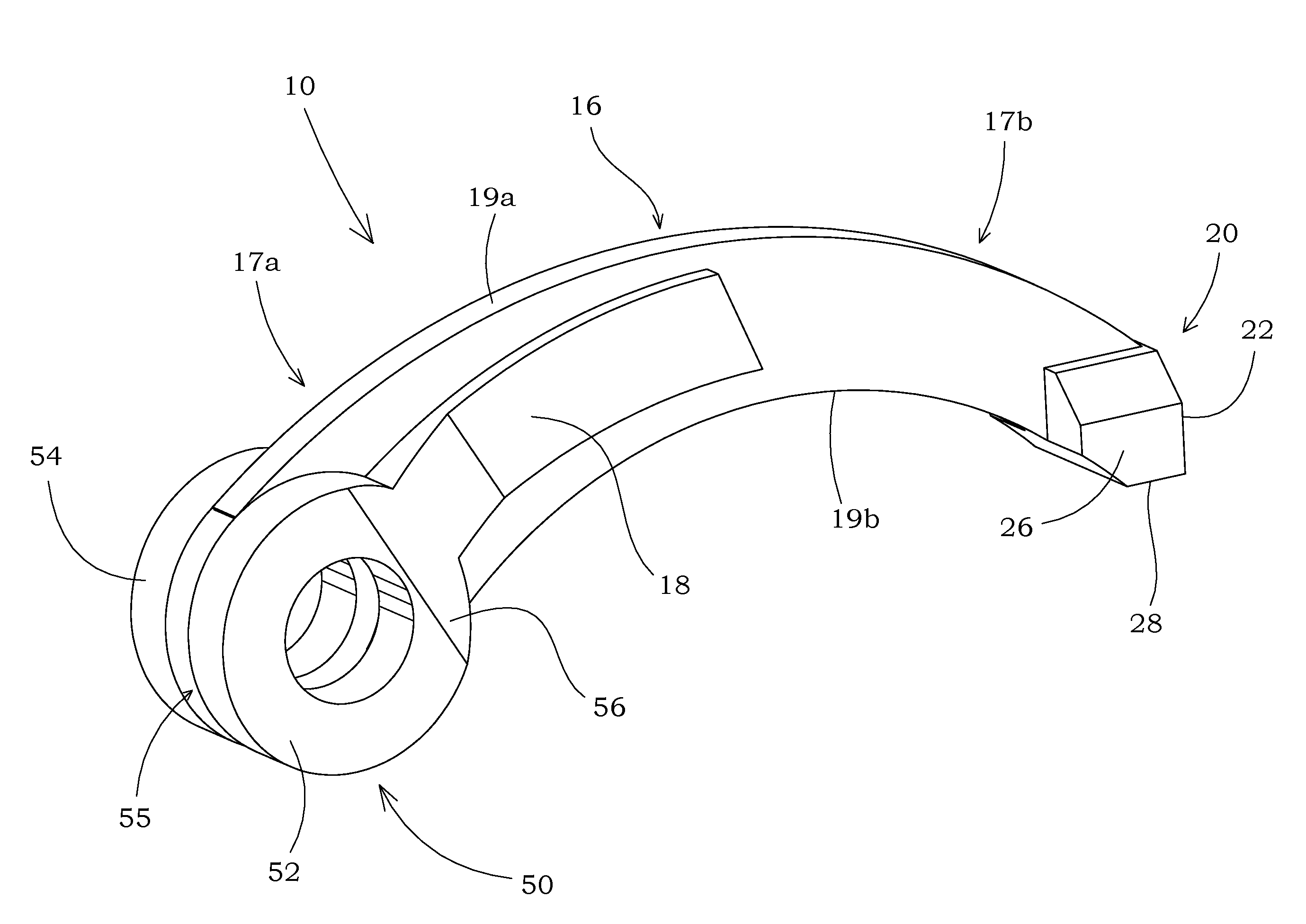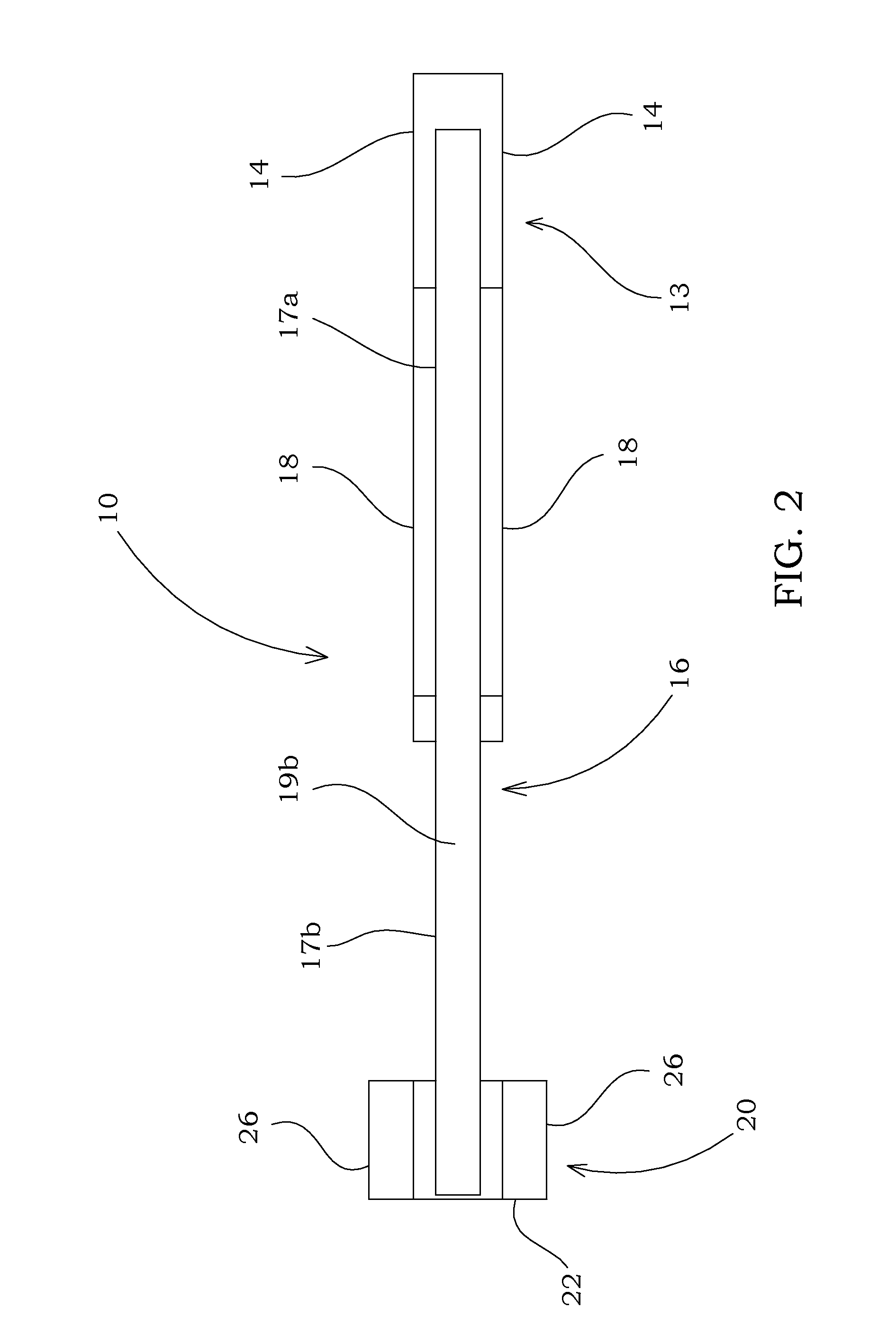Curved hammer
a hammer and hammer mill technology, applied in the field of comminuting or grinding materials, can solve the problems of requiring immediate maintenance and repair, severe damage to the hammermill, and wear of the hammer over a relatively short period of operation,
- Summary
- Abstract
- Description
- Claims
- Application Information
AI Technical Summary
Benefits of technology
Problems solved by technology
Method used
Image
Examples
first embodiment
[0025]A shoulder 14 may be positioned on the connection portion 13 surrounding the rod hole 12, as shown in the various embodiments pictured herein. The shoulder 14 provides increased strength and longevity to the curved hammer 10 in many applications, as is well known to those skilled in the art. In the various embodiments pictured herein, the shoulder 14 is positioned on both sides of the rod hole 12. However, in other embodiments not pictured herein, the shoulder 14 is positioned on only one side of the rod hole 12. The optimal dimensions of the shoulder 14 will vary depending on the specific application of the curved hammer 10, and are therefore in no way limiting to the scope of the curved hammer 10. In the first embodiment, the thickness of the shoulder 14 is 0.75 inches.
[0026]As best shown in FIG. 1, the neck 16 of the curved hammer 10 is non-linear. As shown in the first embodiment herein, the neck bottom surface 19a is derived from a circle having a radius of four and one-h...
second embodiment
[0031]In the second embodiment, the curvature of the neck bottom surface 19a continues through the contact portion 20 and terminates at the bottom contact surface 28. The surface of the contact portion 20 through which the neck bottom surface 19a extends may have the same curvature as that of the neck bottom surface 19a, as shown in FIG. 4. However, in other embodiments, different orientations, angles, or dimensions of the contact portion 20, primary contact surface 22, side contact surface 26, and bottom contact surface 28, may be present without departing from the spirit and scope of the curved hammer 10.
[0032]In the second embodiment of the curved hammer 10, a plurality of welds 24 is affixed to the primary contact surface 22. These welds 24 may be of a hardened material to increase the efficacy and longevity of the curved hammer 10. The materials used to create a weld 24 will vary depending on the specific application of the curved hammer 10, which includes consideration for the...
third embodiment
[0036]The precise distance the void 55 extends through the rod hole 12 may be different in different embodiments not pictured herein, and is therefore in no way limiting to the scope of the curved hammer 10. Furthermore, the precise width of the void 55 (i.e., the distance between the interior surfaces of the first and second arms 52, 54) may be different from one embodiment to the next. In embodiments of the curved hammer 10 not pictured herein, the first and second arms 52, 54 may extend past the rod hole 12 in the direction opposite the neck second end 17b by an amount greater than that shown for the third embodiment pictured herein.
[0037]The curved hammer 10 may be installed in a hammermill assembly to rotate in any direction. However, it is contemplated that from the vantage shown in FIGS. 2A and 4, the curved hammer 10 will rotate in a counterclockwise direction. Accordingly, with most embodiments of a hammermill assembly in the prior art, the curved hammer 10 allows the prima...
PUM
 Login to View More
Login to View More Abstract
Description
Claims
Application Information
 Login to View More
Login to View More - R&D
- Intellectual Property
- Life Sciences
- Materials
- Tech Scout
- Unparalleled Data Quality
- Higher Quality Content
- 60% Fewer Hallucinations
Browse by: Latest US Patents, China's latest patents, Technical Efficacy Thesaurus, Application Domain, Technology Topic, Popular Technical Reports.
© 2025 PatSnap. All rights reserved.Legal|Privacy policy|Modern Slavery Act Transparency Statement|Sitemap|About US| Contact US: help@patsnap.com



